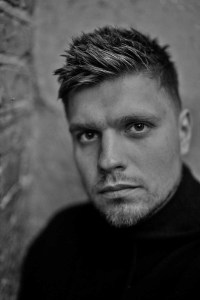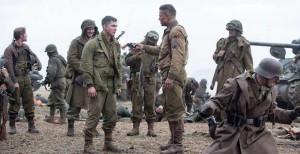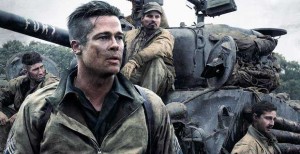
“It’s a war movie, but I saw it as a human story, very soulful and personal, and I wanted to bring the performances to the foreground and keep the flashy action in the background,” said Roman Vasyanov, the director of photography on Fury. “I wanted to make a very naturalistic, minimalist movie. The result I think is a good mix of a European-style movie with classic Hollywood storytelling.”
Fury is the story of an American Sherman tank crew battling for survival and victory over Nazi Panzer tanks behind enemy lines in Germany in the final months of World War II in Europe. That’s where some of the fiercest fighting occurred as the Germans made a desperate last stand. The film spans a 24-hour dawn-to-dawn day. It stars Brad Pitt, as “Wardaddy,” the battle-hardened commander of a five-man crew. Co-stars include Shia LaBoeuf and Logan Lerman, who plays a wet-behind-the ears soldier who has just joined the close-knit group.
“I didn’t want to light it too much or do anything fancy with the camera,” said the Russian cinematographer who now lives in Los Angeles. Instead of trying to emulate big action films like Pearl Harbor, he and director-screenwriter David Ayer looked at some simpler Soviet-era films from the Second World War. “You don’t have to constantly cut to create intensity or action,” he noted. “Instead if you use formal framing, sometimes something magical appears on the screen, and you start feeling reality in a different way.” Vasyanov rejected handheld camerawork and frequently went with long shots. “When you see real footage of World War II, you never see a cameraman running with the camera. Usually, it’s shot on a very long lens,” he observed.

A different challenge was filming the intense final battle, much of which is seen from the close confines of the tank’s tiny interior, where the half dozen U.S. soldiers are crammed on top of each other. Shooting inside an actual tank was impossible, so a set was built only 10 percent bigger than a real Sherman. All the walls had pizza slice openings that could be individually removed in order to put cameras inside. Two and sometimes three cameras were used so the actors could be caught interacting with each other.
Lighting the scene was also tough and required some creative solutions. Vasyanov and his gaffer Lee Walters created a system of LED (light-emitting diode) lights. These were put on the floor and taped to the walls. Flashing lights and overhead lights were added. This setup was all controlled by a dimmer to get the exact amount of light required. “We worked in very low light levels, just enough to get focus and exposure,” the DP noted. “The lighting was quite innovative. Even though it took a lot of work and was very complicated, the whole purpose was to make it look real and believable.”
 Shooting the exterior of the tank was also difficult. To shoot the driving scenes, the tank had to be built on a platform that was put on tracks, and then dragged through mud. “Camera stabilization was a huge problem. A lot of gyro-stabilized heads didn’t work so we had to enhance them,” he said.
Shooting the exterior of the tank was also difficult. To shoot the driving scenes, the tank had to be built on a platform that was put on tracks, and then dragged through mud. “Camera stabilization was a huge problem. A lot of gyro-stabilized heads didn’t work so we had to enhance them,” he said.
A key decision was made to shoot on film instead of with a digital camera. A Panavision camera with G series anamorphic prime lenses was employed. “I knew that our palette of colors would be very restricted, and film has a better color,” he explained.
Tests were done with the Arri Alexa and the Red Epic but they did not do well differentiating greys, greens and blues in, for example, uniforms and also made Brad Pitt’s makeup and other blood-stained visuals seem inauthentic. “There was great resolution, great highlights and a beautiful shallow depth of focus on film. Digital cameras don’t reach that level yet,” he noted. “Also, film was the only kind of platform that would give us this very simple, noir-bluish look that dominated.”
Vasyanov was born in Moscow. His father was a Soviet print photographer who gave him a camera at age 12, starting him on his career path. He studied at the VGIK Russian Film Institute under Soviet cinematographer Vadim Yusov, who shot Ivan’s Childhood, Solaris and Andrei Rublev for acclaimed director Andrei Tarkovsky. After moving to the United States, Vasyanov shot End of Watch for director Ayer. End of Watch received an Independent Spirit Awards nomination for best cinematography in 2012. Ayer and Vasyanov are teaming up again on Suicide Squad, starring Tom Hardy and Jared Leto, to be shot in Toronto in 2015.





